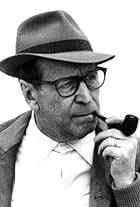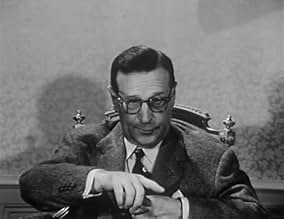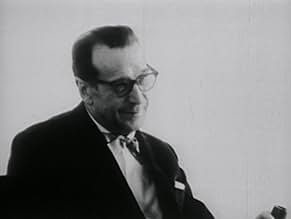Georges Simenon(1903-1989)
- Writer
- Additional Crew
Georges Simenon was a Belgian novelist, writing in the French language. He published nearly 500 different novels, and a large number of short stories. He became internationally famous for creating the French police detective Jules Maigret, as the protagonist in a celebrated series of mystery novels. Between 1931 and 1972, Simenon published 75 novels and 28 short stories about Maigret and his supporting cast. The Maigret stories have often been adapted into films, television series, and radio shows.
In 1903, Simenon was born in Liège, Belgium. His parents were the accountant Désiré Simenon and his wife Henriette Brüll. His father worked as an accountant for an insurance company. They were members of the wider Simenon family, a line of peasants from Limburg whose history had been recorded since the 1580s. Simenon's maternal ancestry was primarily German and Dutch. His mother was reputedly a distant descendant of the famed robber Gabriel Brühl (died in 1743). Simenon would later use the family name "Brühl" as one of his pen names.
In 1905, the Simenon family moved to the Outremeuse neighborhood of Liège, where Simenon would spend most of his childhood. In 1911, they moved to a larger house in the same neighborhood. The family started taking in lodgers to supplement their income. The young Simenon regularly interacted with these lodgers, who were apprentices and students of various nationalities. These interactions gave him his first taste of cosmopolitanism.
In September 1914, Simenon started attending the Collège Saint-Louis, a Jesuit high school. He dropped out of high school in June 1918, deciding against taking his year-end exams. He supported himself through a series of odd-jobs. In January 1919, the adolescent Simenon was hired as a journalist by the newspaper "Gazette de Liège". His assignments consistent of "human interest" stories, which were thought to be of trivial importance. Simenon grew interested in the seamier side of life in Liège, and started to frequent bars and cheap hotels in search of information. He also grew interested in police investigations, and attended lectures on police technique by the famed criminologist Edmond Locard (1877-1966).
Simenon wrote his first novel in June 1919, but it was not published in book form until 1921. During the early 1920s, Simenon started hanging out with members of "La Caque", a group of Bohemian artists. He was introduced by them to Régine "Tigy" Renchon, who became his girlfriend. In 1922, Simenon's father died. Simenon took the decision to move with Tigy to Paris, where he got acquainted with ordinary working-class Parisians. The city's bistros, cheap hotels, bars and restaurants would later become settings for his novels.
In 1928, Simenon took an extended sea voyage for a journalistic assignment. He discovered that he liked water travel. In 1929, he had a boat house constructed for himself and his wife, called the "Ostrogoth". They used it to travel through the French canal system. Joining them in their travels was their housekeeper Henriette "Boule" Liberge, who became Simenon's mistress. Their romantic relationship lasted for decades, unlike Simenon's previous short-lived affairs.
In 1930, Simenon wrote the first Maigret story during a boat trip in the Netherlands. It was published the following year. In 1932, Simenon's journalistic assignments caused him to travel across Africa, eastern Europe, Turkey, and the Soviet Union. In 1933, Simenon interviewed the exiled politician Leon Trotsky in Istanbul. Simenon took a trip around the world from 1934 to 1935. For much of the 1930s, Simenon was a permanent foreign resident in France.
During World War II, Simenon lived in Vendée, France. He maintained decent relationships with the German occupation authorities, and negotiated film rights of his books with German studios. Following the end of the war, Simenon was accused of being a German collaborator, but with little apparent evidence. In 1950, the French authorities temporarily forbid him to publish new works as punishment for his supposed collaboration, but the sentence was not enforced.
In 1945, Simenon left France with his wife for an extended stay in Quebec, Canada. He wrote three novels in the local city of Sainte-Marguerite-du-Lac-Masson. For the following decade, Simenon and his family moved constantly across Canada and the United States. He learned to speak English with relative ease, and so did his mistress Boule. In 1949, Simenon divorced Tigy, but continued living in close proximity with her, in accordance with the divorce agreement. In 1950, Simenon married his second wife Denyse Ouimet (a French-Canadian) in Reno, Nevada. She was 17 years younger than Simenon himself. Denyse was his former secretary, and they had been romantically involved since 1945.
In 1952, Simenon briefly returned to Belgium, as he was made a member of the "Académie Royale de Belgique" (Royal Academy of Belgium). He had not actually lived in Belgium since 1922, but he remained a Belgian citizen and had become the country's most famous writer. Simenon permanently left the United States in 1955. He initially settled back in France, but then decided to move to Switzerland. In 1963, he had a new house constructed for himself in Épalinges, Vaud.
In 1964, Simenon and his wife Denyse separated permanently. His housekeeper Teresa had become his new long-term mistress. In 1978, Simenon was shocked when his daughter Marie-Jo committed suicide at the age of 25. In 1984, Simenon underwent surgery for a brain tumor. He recovered well, but his health further deteriorated during the last years of his life. In September 1989, he died in his sleep while staying in Lausanne,. He was 86-years-old at the time of his death, and had not published any major work for several years.
Simenon's works have remained popular into the 21st century. According to the 2019 version of the Index Translationum by UNESCO, Simenon was the 17th most translated writer on a global scale. In the Index, Simenon outranked the likes of of Astrid Lindgren (18th) and Pope John Paul II (19th). He ranked just below Fyodor Dostoevsky (16th) and Mark Twain (15th).
In 1903, Simenon was born in Liège, Belgium. His parents were the accountant Désiré Simenon and his wife Henriette Brüll. His father worked as an accountant for an insurance company. They were members of the wider Simenon family, a line of peasants from Limburg whose history had been recorded since the 1580s. Simenon's maternal ancestry was primarily German and Dutch. His mother was reputedly a distant descendant of the famed robber Gabriel Brühl (died in 1743). Simenon would later use the family name "Brühl" as one of his pen names.
In 1905, the Simenon family moved to the Outremeuse neighborhood of Liège, where Simenon would spend most of his childhood. In 1911, they moved to a larger house in the same neighborhood. The family started taking in lodgers to supplement their income. The young Simenon regularly interacted with these lodgers, who were apprentices and students of various nationalities. These interactions gave him his first taste of cosmopolitanism.
In September 1914, Simenon started attending the Collège Saint-Louis, a Jesuit high school. He dropped out of high school in June 1918, deciding against taking his year-end exams. He supported himself through a series of odd-jobs. In January 1919, the adolescent Simenon was hired as a journalist by the newspaper "Gazette de Liège". His assignments consistent of "human interest" stories, which were thought to be of trivial importance. Simenon grew interested in the seamier side of life in Liège, and started to frequent bars and cheap hotels in search of information. He also grew interested in police investigations, and attended lectures on police technique by the famed criminologist Edmond Locard (1877-1966).
Simenon wrote his first novel in June 1919, but it was not published in book form until 1921. During the early 1920s, Simenon started hanging out with members of "La Caque", a group of Bohemian artists. He was introduced by them to Régine "Tigy" Renchon, who became his girlfriend. In 1922, Simenon's father died. Simenon took the decision to move with Tigy to Paris, where he got acquainted with ordinary working-class Parisians. The city's bistros, cheap hotels, bars and restaurants would later become settings for his novels.
In 1928, Simenon took an extended sea voyage for a journalistic assignment. He discovered that he liked water travel. In 1929, he had a boat house constructed for himself and his wife, called the "Ostrogoth". They used it to travel through the French canal system. Joining them in their travels was their housekeeper Henriette "Boule" Liberge, who became Simenon's mistress. Their romantic relationship lasted for decades, unlike Simenon's previous short-lived affairs.
In 1930, Simenon wrote the first Maigret story during a boat trip in the Netherlands. It was published the following year. In 1932, Simenon's journalistic assignments caused him to travel across Africa, eastern Europe, Turkey, and the Soviet Union. In 1933, Simenon interviewed the exiled politician Leon Trotsky in Istanbul. Simenon took a trip around the world from 1934 to 1935. For much of the 1930s, Simenon was a permanent foreign resident in France.
During World War II, Simenon lived in Vendée, France. He maintained decent relationships with the German occupation authorities, and negotiated film rights of his books with German studios. Following the end of the war, Simenon was accused of being a German collaborator, but with little apparent evidence. In 1950, the French authorities temporarily forbid him to publish new works as punishment for his supposed collaboration, but the sentence was not enforced.
In 1945, Simenon left France with his wife for an extended stay in Quebec, Canada. He wrote three novels in the local city of Sainte-Marguerite-du-Lac-Masson. For the following decade, Simenon and his family moved constantly across Canada and the United States. He learned to speak English with relative ease, and so did his mistress Boule. In 1949, Simenon divorced Tigy, but continued living in close proximity with her, in accordance with the divorce agreement. In 1950, Simenon married his second wife Denyse Ouimet (a French-Canadian) in Reno, Nevada. She was 17 years younger than Simenon himself. Denyse was his former secretary, and they had been romantically involved since 1945.
In 1952, Simenon briefly returned to Belgium, as he was made a member of the "Académie Royale de Belgique" (Royal Academy of Belgium). He had not actually lived in Belgium since 1922, but he remained a Belgian citizen and had become the country's most famous writer. Simenon permanently left the United States in 1955. He initially settled back in France, but then decided to move to Switzerland. In 1963, he had a new house constructed for himself in Épalinges, Vaud.
In 1964, Simenon and his wife Denyse separated permanently. His housekeeper Teresa had become his new long-term mistress. In 1978, Simenon was shocked when his daughter Marie-Jo committed suicide at the age of 25. In 1984, Simenon underwent surgery for a brain tumor. He recovered well, but his health further deteriorated during the last years of his life. In September 1989, he died in his sleep while staying in Lausanne,. He was 86-years-old at the time of his death, and had not published any major work for several years.
Simenon's works have remained popular into the 21st century. According to the 2019 version of the Index Translationum by UNESCO, Simenon was the 17th most translated writer on a global scale. In the Index, Simenon outranked the likes of of Astrid Lindgren (18th) and Pope John Paul II (19th). He ranked just below Fyodor Dostoevsky (16th) and Mark Twain (15th).























